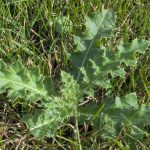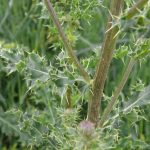Canada and Bull Thistles
Identification:
Bull thistle leaves are coarse on top and soft on the bottom. They are deeply lobed; each lobe has a spine at its tip. Spines extend downward from the leaves along ridges of the stem. Leaves are long near the base and diminish in length as they ascend up the plant. The flower heads are one to two inches wide and gumdrop-shaped. They contain hundreds of tiny purple flowers. Bull thistle flowers bloom two to three weeks after other thistles. Flower heads can appear as a small clump or solitary at the apex of a stem. Blooms spring to early fall. Bull thistle seeds are numerous and straw-colored. The seeds are one tenth to two tenths of an inch long, with plume-like bristles on the tip and are dispersed by wind. The seeds survive in soil for more than 10 years.
Control:
One of the best ways to manage thistles at home, especially in lawns or pastures, is by routine mowing. While this may not eradicate the thistles, it will prevent them from going to seed, preventing any further spread. Ideally, they should be removed fully from the ground and discarded before they reach maturity, however they can sometimes be tricky to spot until they are very large. Canada thistles specifically should be dug up with a spade, as pulling them may leave a rhizome behind. Be sure to look under large, low-hanging evergreen trees, as this is a favorite spot for thistles. Be careful when removing thistles by hand, and wear thick, protective gloves to avoid any injury from the plant.



